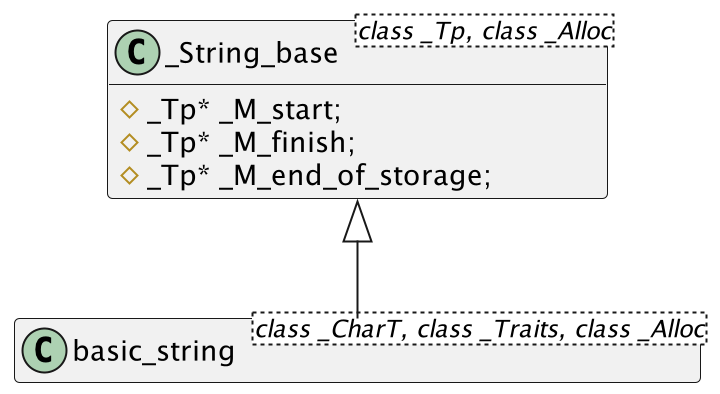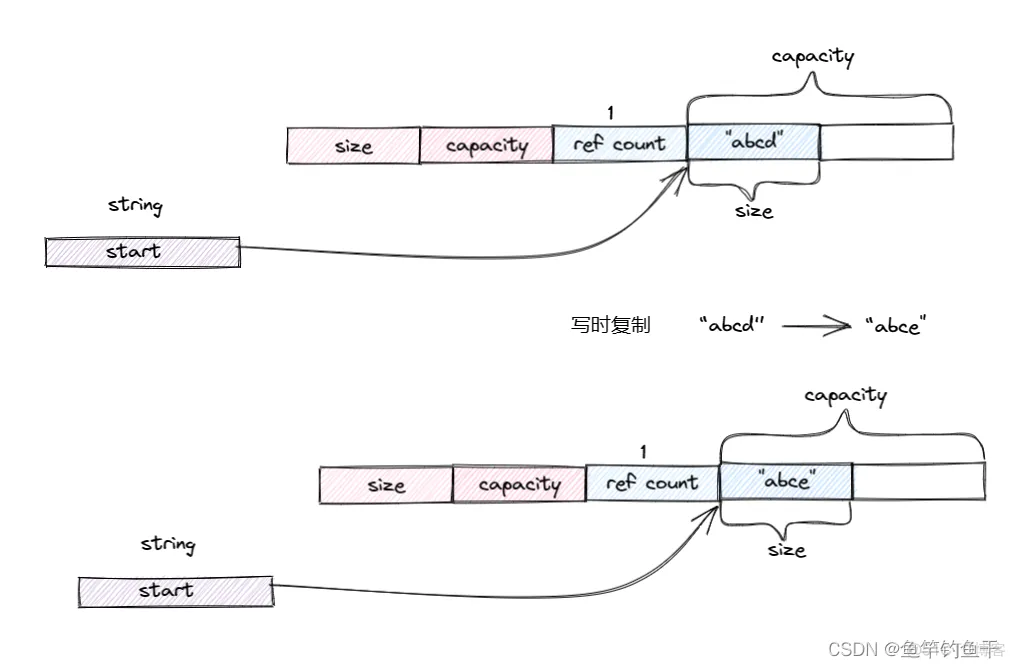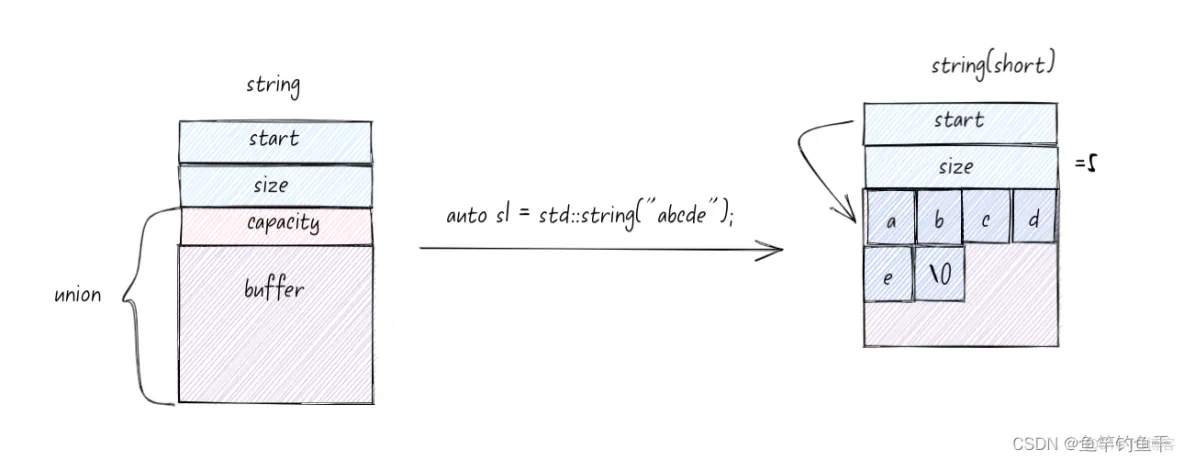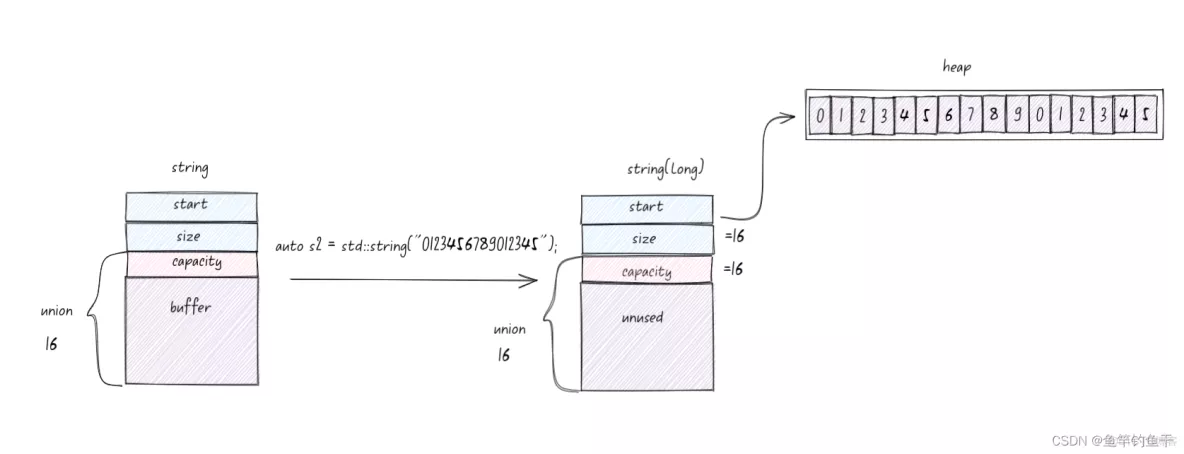string是c++中标准的字符类(其实字节类更贴切),几乎所有项目都在使用(除非是明令禁止),了解其内部实现,可以帮我们更好的使用它。今天来分析下它。
本文分析的是 3.3 版本string,额外介绍了一些新版的实现。
和 string相关的文件包括: stdL_string_fwd.h以及 string 文件。
string 其实是 basic_string的别名:
1 typedef basic_string<char > string;
basic_string实际为一个模板类:
1 2 3 4 5 6 7 8 9 10 11 12 13 14 15 16 17 18 19 template <class _CharT , class _Traits = char_traits<_CharT>, class _Alloc = __STL_DEFAULT_ALLOCATOR(_CharT) > class basic_string;
basic_string的类图如下:
看起来和vector的继承关系基本一样。
1. 默认构造函数·
basic_string默认构造函数:
1 2 3 4 5 6 7 8 9 10 11 12 13 14 15 16 17 18 19 20 21 22 23 24 25 26 27 28 29 30 31 32 33 34 35 36 37 38 39 40 41 42 43 44 45 46 47 48 49 50 51 52 typedef _String_base<_CharT,_Alloc> _Base;explicit basic_string (const allocator_type& __a = allocator_type()) : _Base(__a, 8 ) { _M_terminate_string(); }_String_base(const allocator_type&, size_t __n) : _M_start(0 ), _M_finish(0 ), _M_end_of_storage(0 ) { _M_allocate_block(__n); } void _M_allocate_block(size_t __n) { if (__n <= max_size ()) { _M_start = _M_allocate(__n); _M_finish = _M_start; _M_end_of_storage = _M_start + __n; } else _M_throw_length_error(); } _Tp* _M_allocate(size_t __n) { return _Alloc_type::allocate (__n); } void _M_terminate_string() { __STL_TRY { _M_construct_null(_M_finish); } __STL_UNWIND(destroy (_M_start, _M_finish)); } void _M_construct_null(_CharT* __p) { construct (__p); # ifdef __STL_DEFAULT_CONSTRUCTOR_BUG __STL_TRY { *__p = (_CharT) 0 ; } __STL_UNWIND(destroy (__p)); # endif } template <class _T1 >inline void construct (_T1* __p) _Construct(__p); } template <class _T1 >inline void _Construct(_T1* __p) { new ((void *) __p) _T1(); }
可以看到,调用 string的默认构造函数时,将分配8个char(8Bytes), 并将第一个字节构造为 \0。此时, _M_finish和_M_start同时指向'\0'位置处。
2. += 操作·
1 2 3 basic_string& operator +=(const basic_string& __s) { return append (__s); } basic_string& operator +=(const _CharT* __s) { return append (__s); } basic_string& operator +=(_CharT __c) { push_back (__c); return *this ; }
先看push_back , 下面是老版本实现。
1. push_back·
可能存在扩容,如果当前size=0, 则扩容至2, 如果size!=0, 则扩容至2倍+1.
源码:
1 2 3 4 5 6 7 8 9 10 11 12 13 14 15 16 17 18 19 20 21 22 23 24 25 26 27 28 29 30 31 32 33 34 void push_back (_CharT __c) if (_M_finish + 1 == _M_end_of_storage) reserve (size () + max (size (), static_cast <size_type>(1 ))); _M_construct_null(_M_finish + 1 ); _Traits::assign (*_M_finish, __c); ++_M_finish; } template <class _CharT , class _Traits , class _Alloc > void basic_string<_CharT,_Traits,_Alloc>::reserve (size_type __res_arg) { if (__res_arg > max_size ()) _M_throw_length_error(); size_type __n = max (__res_arg, size ()) + 1 ; pointer __new_start = _M_allocate(__n); pointer __new_finish = __new_start; __STL_TRY { __new_finish = uninitialized_copy (_M_start, _M_finish, __new_start); _M_construct_null(__new_finish); } __STL_UNWIND((destroy (__new_start, __new_finish), _M_deallocate(__new_start, __n))); destroy (_M_start, _M_finish + 1 ); _M_deallocate_block(); _M_start = __new_start; _M_finish = __new_finish; _M_end_of_storage = __new_start + __n; }
push_back流程中:
如果当前有可用空间,则在 _M_finish+1 处构造'\0',并在_M_finish处添加__c
否则,扩容2倍
reserve和 vector的 reserve 基本一致,不再分析。
2. append·
可能存在扩容,2倍扩容或更多(满足要append传入的size)
1 2 3 4 5 6 7 8 9 10 11 12 13 14 15 16 17 18 19 20 21 22 23 24 25 26 27 28 29 30 31 32 33 34 35 36 37 38 39 40 41 42 43 44 45 basic_string& append (const basic_string& __s) { return append (__s.begin (), __s.end ()); }template <class _Tp , class _Traits , class _Alloc > basic_string<_Tp, _Traits, _Alloc>& basic_string<_Tp, _Traits, _Alloc>::append (const _Tp* __first, const _Tp* __last) { if (__first != __last) { const size_type __old_size = size (); ptrdiff_t __n = __last - __first; if (__n > max_size () || __old_size > max_size () - __n) _M_throw_length_error(); if (__old_size + __n > capacity ()) { const size_type __len = __old_size + max (__old_size, (size_t ) __n) + 1 ; pointer __new_start = _M_allocate(__len); pointer __new_finish = __new_start; __STL_TRY { __new_finish = uninitialized_copy (_M_start, _M_finish, __new_start); __new_finish = uninitialized_copy (__first, __last, __new_finish); _M_construct_null(__new_finish); } __STL_UNWIND((destroy (__new_start,__new_finish), _M_deallocate(__new_start,__len))); destroy (_M_start, _M_finish + 1 ); _M_deallocate_block(); _M_start = __new_start; _M_finish = __new_finish; _M_end_of_storage = __new_start + __len; } else { const _Tp* __f1 = __first; ++__f1; uninitialized_copy (__f1, __last, _M_finish + 1 ); __STL_TRY { _M_construct_null(_M_finish + __n); } __STL_UNWIND(destroy (_M_finish + 1 , _M_finish + __n)); _Traits::assign (*_M_finish, *__first); _M_finish += __n; } } return *this ; }
如果当前 capacity 足够容纳传入, 则将传入的范围拷贝至 _M_finish 处。
否则: 扩容(2倍扩容或满足传入的__n大小),然后将老字符串拷贝至新分配地址,同时将传入的要 append 的字符创拷贝至默末尾。
3. cow机制·
上面的实现是非常老的版本了,实际上现代std::string 已经进化了两个版本,一是COW机制,另一个是SSO 短字符串优化 。
cow机制是对std::string 增加了 ref_count原子变量,若字符串变量可以共享存储,只有在有“修改”时才做实际拷贝。 但实际上cow是有一些缺点的:
可能造成野指针:
1 2 3 4 5 6 7 8 9 10 11 12 13 14 15 16 17 18 19 #include <string> int main () std::string str1 ("hello world\n" ) ; const char * p = str1.data (); { auto str2 ( str1) str1[0 ]; } printf (p); return 0 ; }
这是因为 [] 操作符会造成拷贝 ,从而造成失效。
对多线程不够友好。
1 2 3 4 5 6 7 8 9 std::string a = "hello"; std::string b = a; // thread 1 a.pop_back(); // thread 2 b.push_back("x");
比如如上例子,cow对于如上情况,必须考虑一些同步方式,否则会有并发问题。 而引入额外的同步会带来性能衰减。
4. SSO 短字符串优化·
sso短字符串优化考虑到大部分字符串是比较短的,那么可以在栈上预分配一些内存,短字符串字符在栈上存储,达到一定阈值后,才在堆上分配。
这种思想在c++11后挺多的,比如 std::function。
一种实现方式是:
1 2 3 4 5 6 7 8 9 10 11 class sso_string { char * start; size_t size; static const int kLocalSize = 15 ; union { char buffer[kLocalSize + 1 ]; size_t capacity; } data; }
如果字符长度小于15 , 则直接存在栈中,否则存在分配的heap上。 这里又用到了 union trick, 为什么可以使用union?
因为如果字符长度小于15, 直接可以在 buffer 上使用,否则buffer将不再使用, capacity 存放的是 heap 的长度。 start 指向当前可用内存片,size为实际所用大小。
短字符串:
长字符串
扩容和前面的扩容方式一致,2倍扩容。
3. 总结·
老版本std::string和 vector存储方式很相似,只不过默认多存一个\0, 在功能上多了很多function。新版包括 cow (实际上也被遗弃)和 sso_string, 这种小空间占用先放在 stack, 大空间占用再放在 heap 的思想在c++标准库中被反复用到,是个可以借鉴的idea.
4. 参考·
浅谈 C++ 字符串:std::string 与它的替身们_qq6380898cf2b73的技术博客_51CTO博客 深入剖析 linux GCC 4.4 的 STL string - 360 核心安全技术博客






